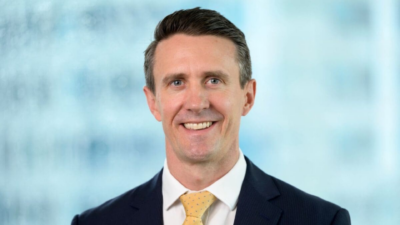Introducing: the biggest firm you’ve never heard of
(Pictured: Cory Martin)
BNP Paribas Investment Partners is offering Australian investors new access to a global value investor which is happy to be known as ‘the biggest fund manager you’ve never heard of’. Barrow, Hanley, Mewhinney & Strauss (BHMS) is a US$100 billion affiliate of Old Mutual which hails from Dallas, Texas.
In Australia to promote the new alliance, whereby BNP Paribas acts as third-party marketer for BHMS in Australia, portfolio manager Cory Martin and client development director Hunter Wood pointed out last week several important distinguishing features about BHMS’s business and investment philosophies and processes.
At the core is the commitment to the value style, which is pure rather than deep. BHMS, alongside other well-known pure value managers, has been prepared to lose some clients during periods of market exuberance, such as the tech bubble. Not all have, though. The former Rothschild Australia, for instance, couldn’t take the pain in 1999 and came up with the notion of “short-term value” to justify buying some growth stocks. Its confused institutional investors deserted the firm, which was subsequently sold to Bankers Trust.
In 2000, BHMS was about 20 per cent behind the S&P 500 index in its US portfolios. But sticking to its style meant that after tech wreck, which started in the run-up to Easter of 2001, it was 56 per cent ahead of the index the following year.
Prior to becoming an affiliate of Old Mutual, which has nine managers in its portfolio, BHMS was an affiliate of United Asset Management, which was the first multi-affiliate manager in the world. UAM had up to 45 affiliates but it also had a flawed revenue-sharing model and got into trouble in the late 1990s. After Old Mutual, based in London, bought the firm in 2000 it shed 36 of those 45 managers. It also introduced a sustainable profit-sharing arrangement which, in BHMS’s case, gives the senior staff an effective 25 per cent of the business in shadow form.
BHMS prides itself on having never lost an investment professional to a rival firm and retaining most of its clients for a very long time. Of its 250 institutional clients, more than 100 have been with the firm for more than 10 years. Two have been there since formation in 1979. The largest single client is Vanguard.
BHMS has no individual investors, gaining its retail exposure as a sub-advisor to other mutual fund managers. Of its 80 staff, only three are in sales and marketing. Wood said: “About 95 per cent of our business comes from referrals and through asset consultants.”
He said: “Stability, consistency and culture are our key values. We will adhere to our value style in a disciplined manner through all cycles.”
Of the firm’s US$9 billion invested outside the US, $US4.2 billion is in its global fund being offered in Australia. In 2012 the firm also launched an emerging markets value fund and is currently looking at providing a concentrated version of the global fund. The global fund has between 50-70 stocks and a concentrated one would have 25-30 stocks.
Martin says the firm emphasizes free cashflow in its favoured stocks and companies that can continue to grow their dividends. “We love share buybacks but we prefer dividends,” he said. “Dividends show the management’s confidence in their ability to grow free cashflow.”
His biggest overweight position on a sector basis is among financials, which the firm believes will benefit from an environment of moderately higher interest rates.
Emerging markets remain cheap, but not all markets. Latin America and Mexico, for instance, are expensive. Japan is the cheapest market in the world, apart from Russia (“they have good reason to be cheap”), but until recently BHMS has been concerned about Japanese companies’ focus on return on equity to shareholders. It recently added a Japanese conglomerate to its global portfolio. The US, on an absolute multiple basis, is the most expensive market.










